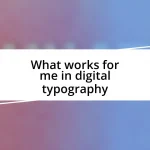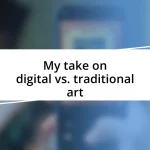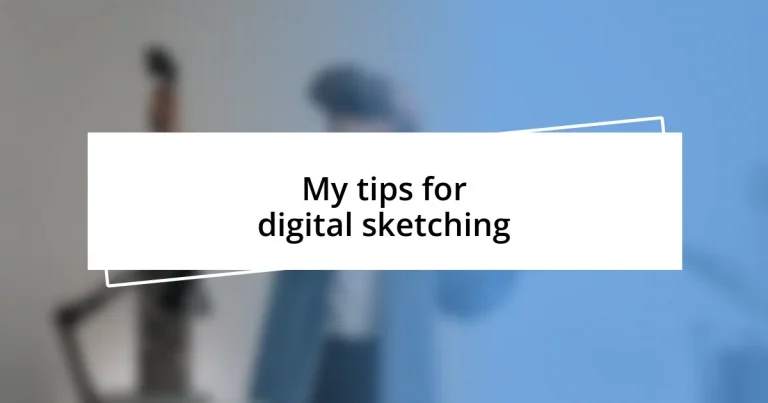Key takeaways:
- Choosing the right digital sketching tools and software greatly influences creativity and workflow; user-friendly interfaces and customizable options enhance the artistic experience.
- Investing in quality hardware, such as tablets and styluses with good pressure sensitivity, significantly impacts sketching precision and overall enjoyment.
- Utilizing layers effectively streamlines the creative process, allowing for easier adjustments and mistake erasure, while naming layers improves organization and efficiency.
- Engaging with audiences by sharing insights about the creative process and selecting the right platforms for showcasing art fosters deeper connections and constructive feedback.
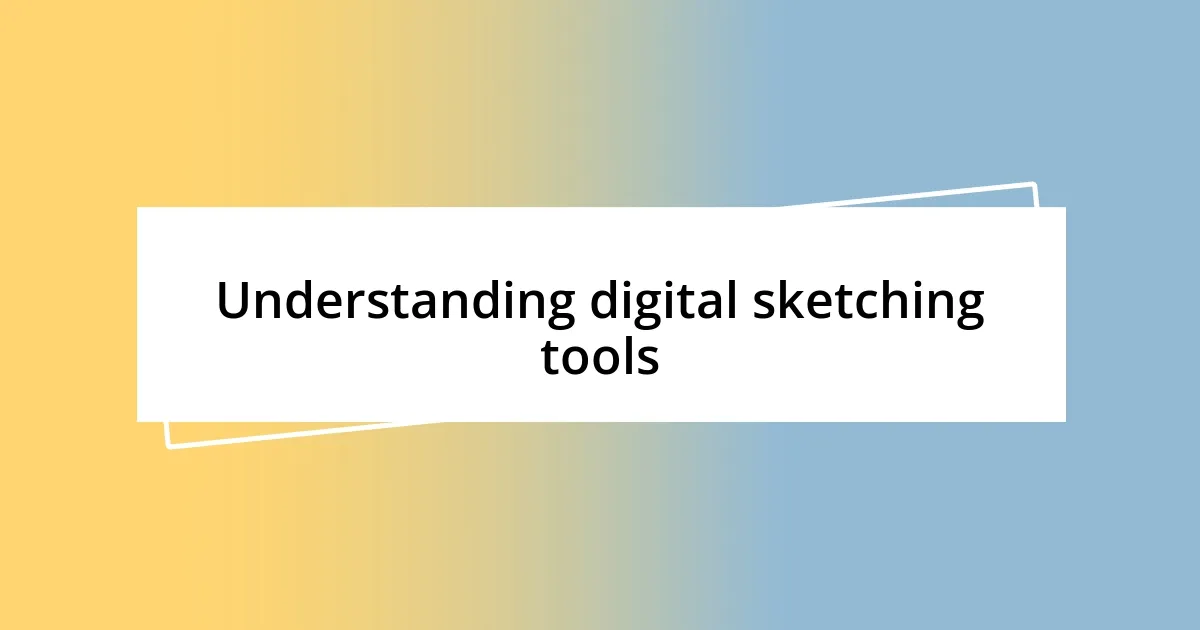
Understanding digital sketching tools
When I first dove into digital sketching, the sheer variety of tools available was both overwhelming and exhilarating. From tablet styluses to software like Procreate and Adobe Fresco, each tool has its own personality and quirks. Have you ever found yourself drawn to a specific brush or color palette? I definitely have—there’s an emotional connection that forms as you discover what resonates with your artistic style.
I remember my initial struggles with pressure sensitivity settings on my stylus; it felt like a chore to get the settings just right. But once I did, it transformed my sketches, allowing for a more natural flow. Understanding these settings isn’t just about technicality; it’s about how they can enhance your creativity. Have you felt the difference when everything clicks into place? It’s almost magical.
Moreover, I’ve realized that choosing the right software can shape my mood for the day. For instance, when I use more intuitive apps with simple interfaces, it’s like stepping into a creative flow with ease. On the other hand, complex programs can sometimes feel like a barrier. What about you—do you favor one tool over another, and how does it impact your creative process?

Choosing the right software
Choosing the right software is crucial. Early on, I experimented with a few programs, and each had its learning curve. I vividly remember the frustration of trying out a highly recommended software only to find that the interface felt cluttered and unintuitive. It stifled my creativity. Choosing software that feels comfortable to use can make a huge difference in how freely ideas flow onto the screen.
Here’s a quick rundown of what to consider when selecting software:
- User Interface (UI): Is it intuitive, or does it require extensive tutorials to navigate?
- Brush Selection: Are there enough customization options to match your style?
- Pressure Sensitivity: Does it recognize your stylus pressure accurately?
- Compatibility: Can it run on your device smoothly without lag?
- Versatility: Is it suitable for more than just sketching, like painting or graphic design?
- Community Support: Are there online resources, tutorials, or forums available for help?
Finding the right fit for your artistic expression can feel like finding the perfect brush; it shapes not only your work but also your mood and workflow.
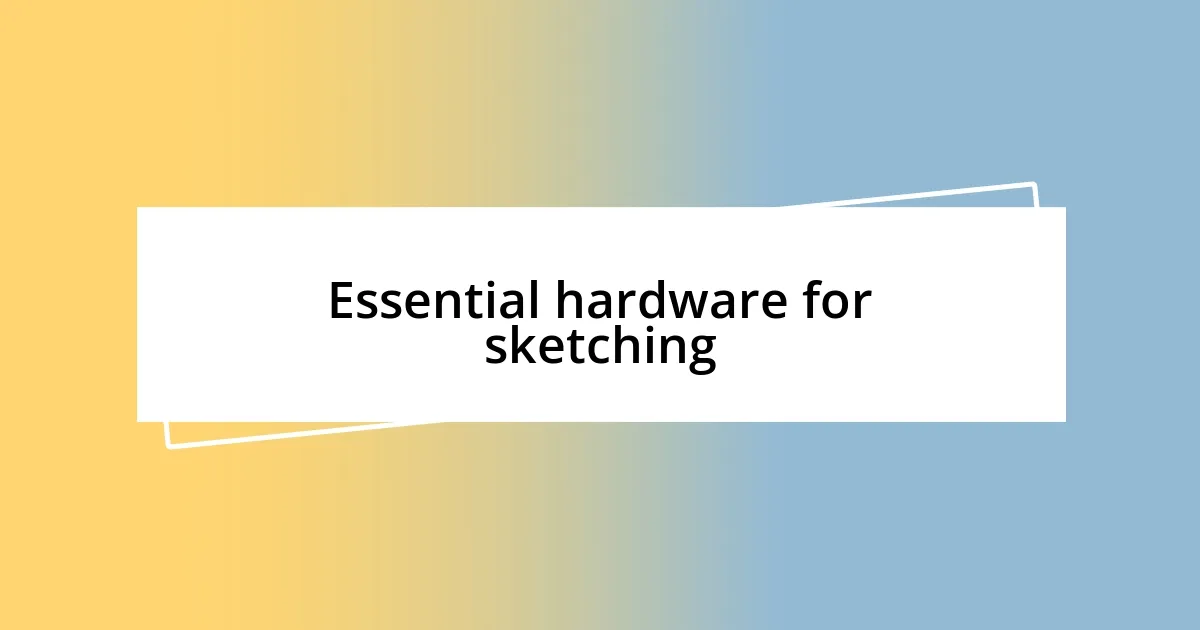
Essential hardware for sketching
Choosing the right hardware for digital sketching can profoundly influence your creative journey. I’ve personally found that investing in a quality drawing tablet made all the difference in my work. Initially, I used a basic tablet, but the lack of pressure sensitivity and responsiveness left me feeling detached from my sketches. The moment I upgraded to a more advanced tablet, it felt like a bridge to my ideas, allowing me to translate my thoughts onto the screen seamlessly.
When it comes to styluses, not all are created equal. I remember using a stylus that came with my first tablet—it was clunky and didn’t feel natural to hold. It turned sketching into a task rather than a pleasure. After some research, I switched to a stylus specifically designed for art, one that had a comfortable grip and impressive pressure sensitivity. This change not only improved my drawing precision but also reignited my passion for sketching.
As for screens, I can’t emphasize enough the impact of using a tablet with a high-resolution display. The first time I sketched on a device with a clear and vibrant screen, I was blown away. Colors popped, and details stood out in ways I had never experienced before. It truly changed how I viewed my work—it felt less like a digital replication and more like a genuine piece of art. Have you had a similar experience with different devices?
| Hardware | Key Features |
|---|---|
| Drawing Tablet | Pressure sensitivity, responsiveness, portability |
| Stylus | Comfortable grip, varying levels of pressure sensitivity |
| Display Screen | High resolution, color accuracy, touch functionality |
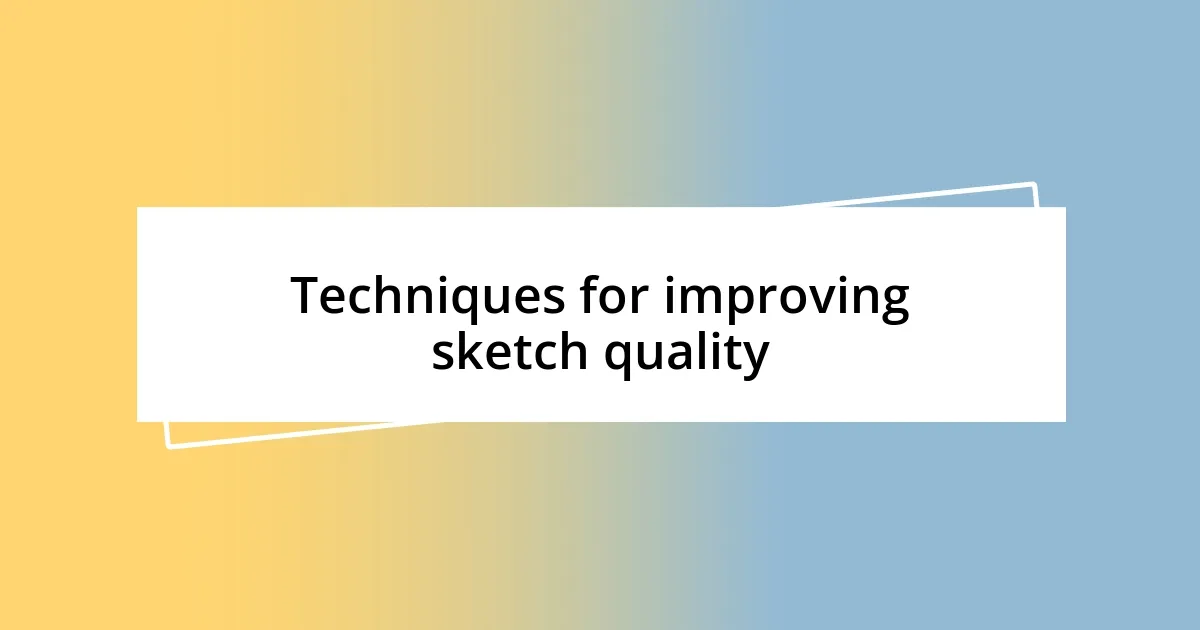
Techniques for improving sketch quality
Finding ways to improve sketch quality is like training a muscle—it requires practice and specific techniques. One method I often use is practicing with different brush styles. Initially, I was reluctant to experiment, sticking to a single brush that I was comfortable with. However, when I finally took the plunge to try out a variety of brushes, I was amazed at how each one brought a unique texture and feel to my sketches. It was as if I had opened a toolbox filled with new tools ready to shape my artistic vision.
Another critical technique I’ve learned is to utilize layers effectively in my sketches. At first, I didn’t appreciate the value of layering and often muddled my lines together. Once I started separating different elements into layers, it was like putting my sketches on a whole new level. It allowed me to make adjustments without losing my original work and provided the flexibility to experiment with colors and shading. Have you ever felt the sudden relief of erasing a mistake without a trace? It’s a game changer.
Finally, don’t underestimate the power of feedback. I used to shy away from sharing my work, fearing harsh criticism. However, once I opened myself up to feedback from fellow artists, I noticed a significant boost in my skills. Listening to constructive criticism can illuminate blind spots I didn’t even know existed. It’s like having a personal coach who guides you toward areas of improvement that can elevate your sketches from good to extraordinary. How often do you seek input on your work, and how has it affected your growth as an artist?
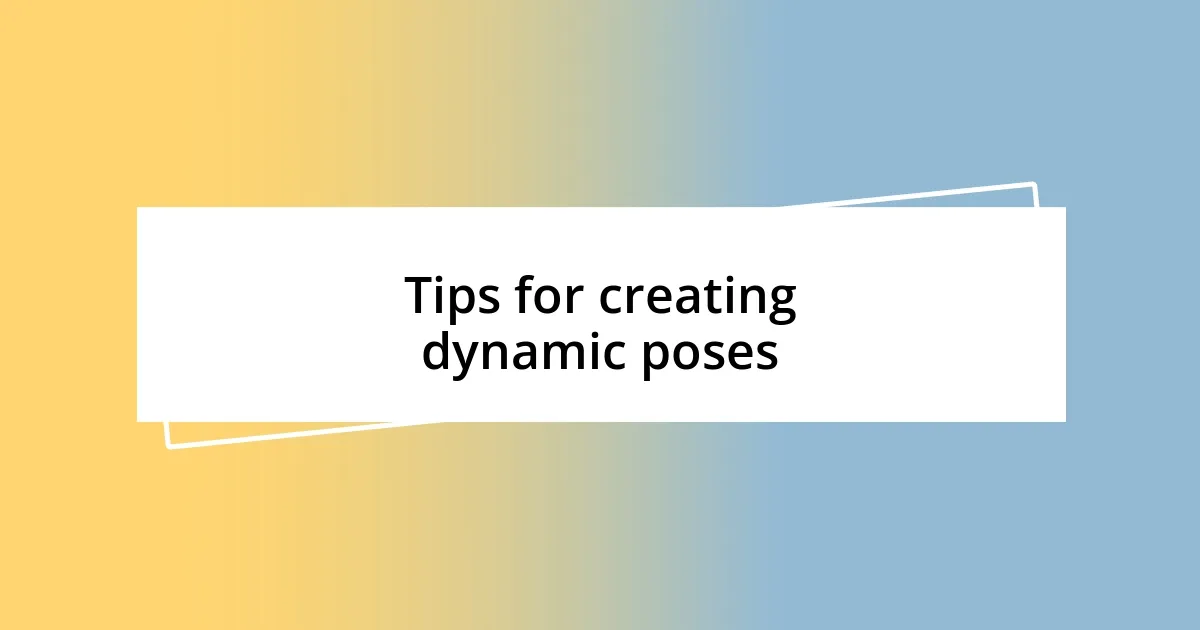
Tips for creating dynamic poses
Creating dynamic poses is a thrilling challenge that can really elevate your sketches. One tip I’ve found invaluable is to study real-life movement. I often find myself observing friends or even pets as they play, capturing their fluid motions in quick sketches. There’s something magical about translating that life energy into art—it adds a certain spark that static poses can’t match. Have you ever tried sketching someone mid-laugh? The excitement of that moment is something you can almost feel on the page.
Another approach that has worked wonders for me is exaggerating the anatomy in my sketches. When I first experimented with stretching limbs or exaggerating certain angles, it felt counterintuitive, but the result was always striking. This technique helps create a sense of action and emotional intensity. I vividly remember a time when I exaggerated the arc of a dancer’s arm; it immediately transformed the composition, making it come alive. Have you considered how slight changes in perspective could shift the viewer’s emotional response to your art?
Lastly, I can’t stress enough the importance of gesture drawing in mastering dynamic poses. For me, the thrill of a timed sketch session, where I often only have a minute or two to capture a pose, pushes me out of my comfort zone. It forces me to focus on the essence rather than the details, creating a more captivating sketch. I recall a day spent at a local figure drawing class—my sketches were rough but full of energy. Do you find that letting go of perfection can lead to fresher ideas? Embracing this mindset has truly transformed the way I approach poses in my digital sketches.
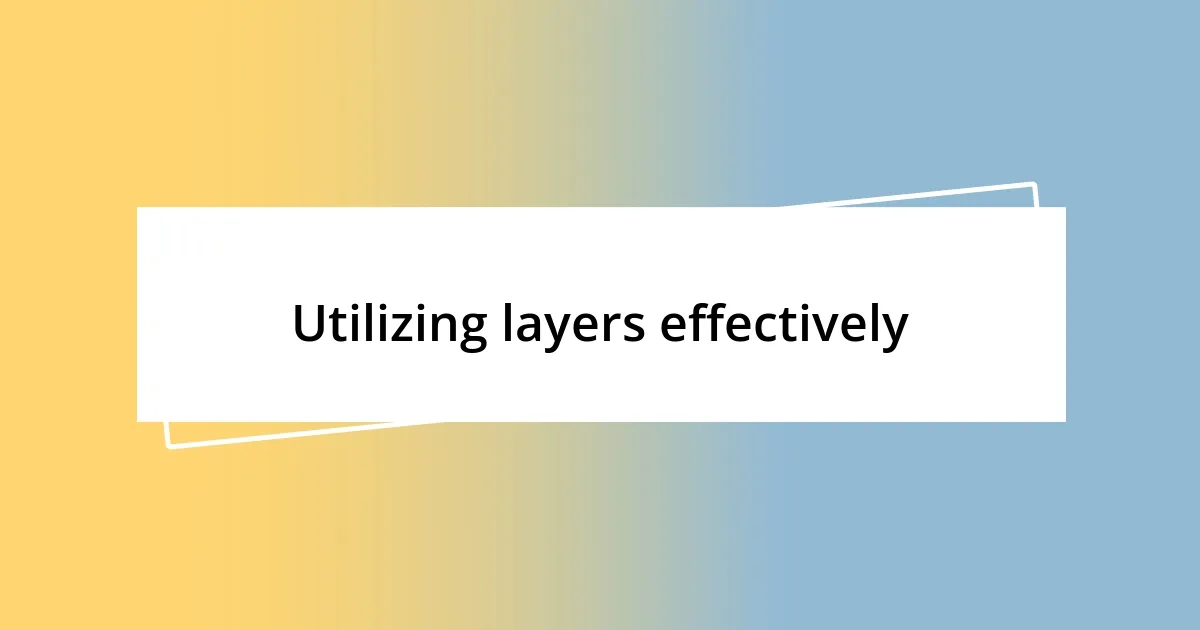
Utilizing layers effectively
Utilizing layers is one of those game-changing techniques that I genuinely wish I had embraced sooner. Initially, I didn’t grasp how powerful they could be in organizing my workflow. I remember a time when I was tackling a particularly complex illustration, and I hesitated to separate elements onto different layers. Once I finally did, it was like uncovering the hidden potential of my artwork. I could move characters without disturbing the background, add shadows effortlessly, and refine details without the fear of ruining my previous work. Isn’t it liberating to know that mistakes can be undone almost seamlessly?
I also find that naming my layers is a simple yet vital practice that improves my efficiency tremendously. It may seem trivial, but trust me, I learned the hard way during a late-night sketching spree, as I urgently searched through layers labeled “layer 1,” “layer 2,” and so on. Now, I take a moment to label them accurately—such as “foreground character” or “shadows” — before I lose track. It seems small, but this habit saves me so much time and headache during the creative process. Have you ever found yourself in a tangled mess of layers? Taking the time to organize can truly streamline your artistic journey.
Moreover, I love using layer blending modes to add depth and texture to my sketches. The first time I experimented with overlay and multiply modes, I was hooked. Suddenly, colors popped and shadows deepened in ways that made my work feel more dynamic. I vividly recall a portrait I worked on; by playing with these modes, I transformed flat colors into vibrant, lively tones. Have you explored blending modes in your sketches yet? They’re a fantastic way to explore new visual dimensions without having to start from scratch.
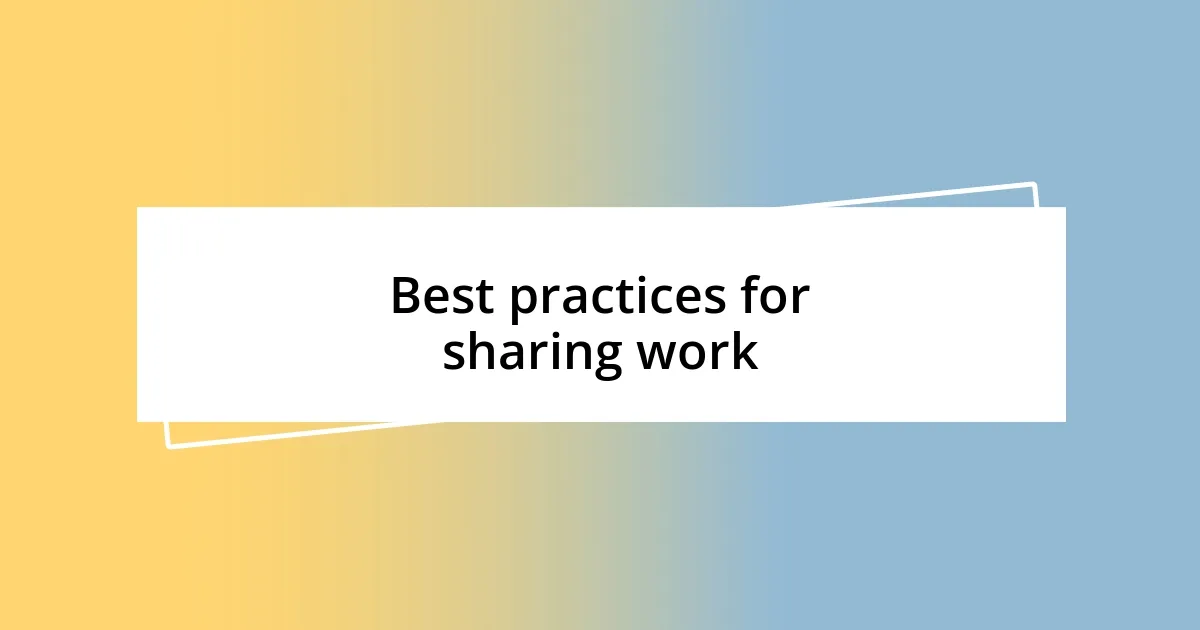
Best practices for sharing work
When it comes to sharing my work online, I’ve found that context is everything. I always try to accompany my sketches with a brief story or insight about the creation process. For instance, I once shared a piece that captured a fleeting moment of joy at a local festival. Including a few lines about what inspired that sketch not only resonated with viewers but also created a deeper connection to the artwork. Have you ever noticed how a little background can transform a simple image into a memorable experience?
Selecting the right platform for sharing is another essential practice. Each platform has its own vibe. On Instagram, quick snippets often work best, while sites like DeviantArt cater to more detailed critiques. I remember when I switched from posting on social media to joining online art communities. The feedback I received was invaluable and opened my eyes to areas of improvement I hadn’t considered. How do you decide where to showcase your work? Understanding the nuances of different platforms can significantly elevate how your art is received.
Lastly, engaging with your audience plays a critical role in sharing your work. I make it a point to respond to comments and ask questions about viewers’ impressions of my sketches. Just the other day, a follower shared how a piece I created resonated with a moment in their own life. That interaction not only made my day but also inspired future works! Have you taken the time to connect with your audience? Building an interactive dialogue can foster a supportive community around your art, enriching both your experience and theirs.


